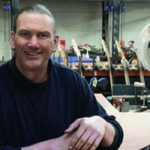There’s always a better way to make… everything!
By Jon Liebman
Week of December 28, 2020
I first met Tomm Stanley in London about 5 years ago. Though he lives all the way in far-off New Zealand, we’ve become good friends, corresponding often and seeing each other in person as much as possible. So it was great fun doing a one-on-one Facetime chat with Tomm for the interview we published this week on FBPO.
Tomm is the founder of Stonefield Musical Instrument Company, maker of some of the most outstanding basses I’ve ever played.
Before he launched Stonefield, I can’t say Tomm was completely unsatisfied with the basses that were commercially available, but, given the way his mind works, he’s always felt that certain things could be made better, whether it meant improvements in tone, balance, ease of playing, or a hundred other things.
It turns out his ideas are amazing!
“I actually sat and wrote out a list of things,” Tomm says, “that, over the years, I’d wondered why these things are not on bass guitars.”
The list included things like floating bridges, a wider variety of tone options, and a more optimum body shape, to name just a few items that are part of a never-ending quest to make an overall better instrument.
“I started experimenting with, ‘What would I want in a bass?’ Tomm says. “That’s where the company’s slogan, The bass you’ve always wanted, came from.”
One thing led to another and before he knew it, Tomm had built a few basses. Right away, he knew he was on to something and thought, “Man, this would be so neat to do this for a living. And why not?”
Stonefield basses feature Tomm’s signature tuning system, a multitude of frequency controls, specially angled neck, and other features that make his basses really stand out.
But Tomm’s obsession is not limited to basses. Determined to find a way to get great sound – and great power – out of a lightweight amp, he introduced the Stonefield Mighty Mini, the Mini Plus, and the Sub Mini amplifiers. Barely three feet tall, the right configuration will deliver up to 500 watts. They “absolutely just shake the walls!” Tomm says.
It just goes to show you that, no matter how good a product is, there’s always some aspect of it that can be improved. It’ll be interesting to see what Tomm and other like-minded bass makers come up with next. I for one am eager to find out!
How about you? Have a thought on the subject? Leave a comment below and let me know what you think. In the meantime, check out my interview with Tomm here.






It would have been interesting to ask about the tradeoff between possible advantages of the floating bridge and the disadvantage that neither string height nor intonation is individually adjustable.
El más grande solo tenía 4 cuerdas.No necesitaba más,y el más grande del contrato 4 también.
Hi Kim,
I saw your question here so thought I’d come back to you directly with an answer. From the side of advantages, the wooden bridge provides a noticeable warmth to the tonality of the instrument. That doesn’t mean it can’t be sharp or punchy but there’s a tonal … X factor. for lack of a more defined description … that can be distinctly heard when changing between wood and metal in contact with the strings. On the side of concerns: if you’re a person that forever like to fiddle with their height and intonation, then yes, there might be an issue with using this style of bridge. Intonation will never be 100%, drop-dead accurate for all strings but you have two that are perfect and the rest are so close that even chords in the second octave sound without dissonance. The individual string height adjustability might be an issue to some but with the exception of the non-adjustable single-piece bridge that we offer, the three-piece wooden and the thumbwheel version do provide height adjustment. If the way we set-up the bass string-to-string isn’t quite what you like, the instrument may require a visit to a tech or luthier but it’s a simple process that anyone with experience can sort out with you in under a half hour.
Thanks for your question,
Tomm Stanley